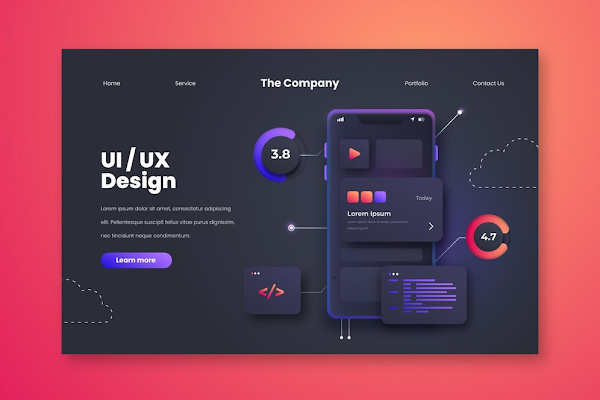As a Senior UX/UI Designer, the quest for crafting intuitive and user-centric web experiences is akin to stepping into the role of a UI/UX superhero. In this dynamic world, we navigate through the principles of the 4 C's—Clarity, Consistency, Concision, and Contextuality—to unravel the secrets of creating captivating digital landscapes that captivate users.
UI/UX Superhero: Crafting Intuitive, User-Centric Web Experiences that Captivate
As a Senior UX/UI Designer, the quest for crafting intuitive and user-centric web experiences is akin to stepping into the role of a UI/UX superhero. In this dynamic world, we navigate through the principles of the 4 C's—Clarity, Consistency, Concision, and Contextuality—to unravel the secrets of creating captivating digital landscapes that captivate users.
1. The 4 C's of UX: Guiding Principles
Clarity is our first beacon. It's about presenting information in a way that users can easily comprehend. Consistency follows suit, ensuring that the design language remains harmonious throughout the web experience. Concision trims the excess, keeping the interface focused and efficient. Contextuality tailors the user experience to specific scenarios, acknowledging the diverse contexts in which users interact.
2. Unveiling the 5 Facets of User Experience UX Design
User experience (UX) design is a multi-faceted endeavor. Information Architecture structures content for easy navigation. Interaction Design focuses on creating intuitive and responsive user interfaces. Visual Design adds a layer of aesthetic appeal. Usability Testing validates designs through user feedback, and Accessibility ensures inclusivity for users with diverse needs. These facets collectively define the user journey, ensuring a holistic approach to design.
3. The Core Processes of Designing UX: An Overview
Designing UX is not a linear journey but a series of interconnected processes. Research and Discovery involve understanding user needs and market trends. Design and Prototyping bring ideas to life through tangible solutions. Testing and Iteration refine designs based on user feedback, and Implementation and Launch ensure a seamless transition from design to the final product. These processes form a continuous loop, fostering iterative improvements.
4. The 4 Elements of UX Design: A Deep Dive
Within the tapestry of UX design, four essential elements form the building blocks. Information Architecture lays the groundwork for organizing and structuring content. Interaction Design crafts intuitive and responsive interfaces. Visual Design adds the aesthetic layer, and Usability Testing validates designs through real-world user interactions. These elements synergize to create seamless and enjoyable user experiences.
5. Clarity: The Beacon in User-Centric Design
The superhero's journey begins with clarity. Clear design communicates effortlessly with users, guiding them through the digital landscape with ease. Whether it's concise copy, well-structured navigation, or intuitive interactions, clarity is the compass that ensures users feel confident and empowered throughout their journey.
6. Consistency: The Harmony in User Interfaces
Consistency is the melody that resonates through user interfaces. It creates a sense of familiarity, making users comfortable and confident in their interactions. From the placement of buttons to the use of color schemes, maintaining a consistent design language fosters a cohesive and predictable experience, enhancing usability and overall satisfaction.
7. Concision: Trimming the Excess for Focus
Concision is the superhero's ability to trim the excess, keeping the interface focused and efficient. In a world inundated with information, concise design ensures that users can quickly grasp key elements and navigate without unnecessary distractions. It's the art of delivering the most value with the least amount of complexity.
8. Contextuality: Tailoring Experiences to Users
Understanding the diverse contexts in which users engage with a web experience is the hallmark of contextuality. A UI/UX superhero tailors the design to align with specific scenarios, ensuring that the user experience remains relevant and adaptable. Whether on a desktop, tablet, or smartphone, the design seamlessly adjusts to meet the user's needs.
9. Information Architecture: Building a Solid Foundation
Information Architecture is the superhero's blueprint for building a solid foundation. It involves organizing and structuring content in a way that makes sense to users. A well-crafted information architecture ensures that users can easily find what they're looking for, fostering a sense of navigation that feels intuitive and logical.
10. Interaction Design: Crafting Intuitive Interfaces
Interaction Design is the superhero's artistry in crafting intuitive interfaces. It focuses on the way users interact with the product, ensuring that every click, swipe, or tap feels natural and responsive. By understanding user behaviors, a UI/UX superhero creates interfaces that seamlessly guide users through their digital journey.
11. Visual Design: Adding Aesthetic Appeal
Visual Design is the superhero's touch of aesthetic appeal. Colors, typography, and imagery are carefully chosen to evoke specific emotions and convey the brand's personality. The visual elements serve as the superhero's tools, transforming a functional interface into a visually engaging and memorable experience.
12. Usability Testing: Validating Designs Through User Feedback
The superhero's journey concludes with usability testing. This involves observing real users interacting with the design, uncovering potential stumbling blocks, and validating design decisions. Usability testing is the superhero's reality check, ensuring that the final product not only looks good on paper but resonates positively with users in real-world scenarios.
